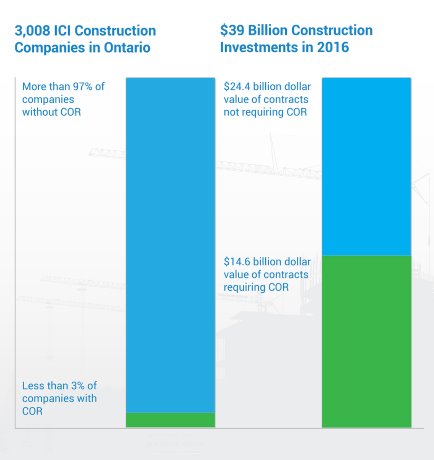Industrial-Commercial-Institutional construction prequalification processes have significantly evolved over the past 10 years.
Competition is becoming fierce with smaller companies building up capabilities and qualifications, and foreign companies gaining access to the market. As competition increases, construction buyers are demanding higher standards of service and have increased prequalification expectations.
Contractors’ safety records and systems are becoming an increasingly important part of the prequalification process as incidents can drastically delay construction projects. Construction buyers are recognizing that companies dedicated to continuously improving safety avoid time loss and produce higher quality work.
This trend is particularly noticeable in Ontario where major buyers of construction: Infrastructure Ontario, Metrolinx and TTC have begun requiring the Certificate of Recognition (COR) for prequalification. As of 2015, all Metrolinx contracts, TTC contracts over $5 million and Infrastructure Ontario contracts over $10 million require COR. It is anticipated that by fall 2016, Infrastructure Ontario projects over $10 million will require COR. In June, York Region announced that bidders have the option of enrolling in COR as an alternative to ISNetworld.
The goal of COR is to reduce the human and financial cost of workplace incidents while delivering on-time and on-budget infrastructure projects for Ontarians. In Western Canada, injury rates for firms achieving COR are an astounding 57 per cent lower than their peers. This also has a substantial impact on a key cost component for construction firms: insurance premiums. Overall, the shift to achieving COR is expected to shake up the competitive landscape just as it has in Alberta, where very few medium or large construction firms survive without COR.
We can already see the shift in the competitive landscape. From 2015 to 2016, the capital expenditure budgets of Metrolinx, Infrastructure Ontario, York Region and the TTC totals $14.6 billion.
The total for non-residential construction investment is expected to be $39 billion for 2016 . This means that nearly 40 per cent of dollars spent on commercial construction will only be available to companies with COR.
Currently, out of approximately 3,000 non-residential construction companies in Ontario, less than 100 have COR. As more construction buyers also begin demanding COR for prequalification, the pool of contracts requiring COR will grow and companies without COR will be left behind.
This begs the question: why aren’t more companies working towards it?
For companies who haven’t evolved their safety program recently, COR can be a difficult standard to achieve. It requires documented proof of a functional safety program. The sheer amount of paperwork and administrative tasks can be overwhelming.
However, with recent developments in technology, achieving COR is becoming easier. Site supers and foremen already use smartphones to communicate onsite; that same technology can support a more efficient safety reporting process, which is vital to achieving COR. eCompliance.com, a safety software company, has partnered with safety and industry associations across Canada to offer a user-friendly web and mobile solution to easily achieve COR, and enhance safety, quality and risk management across a firm’s projects.
COR is becoming essential for construction companies wanting to stay competitive, but it’s about more than qualifying for major bids; it’s simply a byproduct of a well-executed safety program. By embracing new technologies like eCompliance, companies will improve management visibility, reduce administrative costs and ensure that stronger safety performance translates into a stronger competitive position for years to come.
Adrian Bartha is the CEO of eCompliance, a leading health and safety management software solution company. For more information visit www.ecompliance.com. To comment or propose Industry Perspectives column ideas email editor@dailycommercialnews.com.












Recent Comments
comments for this post are closed